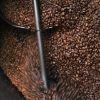A blog for the coffee lovers
Welcome to the PureBean Blog. Stay updated with our latest news & information.

Home Coffee Roasting Basics
Make no beans about it, people LOVE their coffee; fresh coffee too! If you are the neighborhood coffee aficionado, it’s time to take your coffee knowledge up to the next level because, let’s face it, anyone can buy a cup from the local coffee shop; not everyone has what it takes to roast their own pot! If you’re interested in learning how to roast coffee from home, you’ve come to the right website. Read on to learn the basics of roasting coffee from home.
Let’s Clear the Air
If your goal is to become the neighborhood coffee connoisseur, I want you to know this fact. Coffee beans aren’t actually beans; in fact, coffee beans are the seeds of the coffee plant. The coffee plant produces cherries and the coffee “beans” are found inside these cherries. Who would have thought that! And guess what? The coffee “bean” is actually the colour green, and it’s through the roasting process where the beans start to look and smell like the coffee bean that you and I are accustomed to seeing.
Coffee Roasting Simplified
Essentially coffee roasting is the art of taking an uncooked bean and cooking it until it’s done. You can tell the roast of the coffee bean by the color. That being said, when it comes to roasting coffee beans, you have a few options to get the job done at home.
These options include using a stove, using an oven, using a grill, using a popcorn machine and of course a coffee roaster. For all intents and purposes, this article is going to focus on using the stove top method as most houses have access to a stove.
What Do You Need?
For starters, you’ll need a stove, access to a window / ventilation, an attention span, a stainless steal popper with a crank (think of the popper you use to pop popcorn on the stove) a metal colander, a glass jar, a thermometer and of course, uncooked coffee beans!
Benefits of Using the Stovetop Method
- – You can roast more in one batch using the stovetop than using a roaster. This means one roast session can provide you with enough beans for a week!
- – You can make all styles of coffee roasts using this method. Do you know how coffee makers refer to their roasts by names such as light roast, medium roast and dark roast? What they are referring to is the amount of time a coffee bean is being roasted. A light roast is roasted for a short amount of time, a dark roast is roasted for a longer amount of time.
- – You get to make coffee like our ancestors did – over heat.
Drawbacks of Using The Stovetop Method
- -Roasting beans over the stove requires steady manual labor; you will need to crank the popper to stir the beans during the entire roasting time.
Roasting the Beans
It’s time to get the party started; it’s time to roast some coffee! The first step is to place the popper on the stove and preheat it to 400 degrees. During this time, make sure you turn the air ventilation on and open any and all windows. Once you are sure the temperature is ready to go, dump 8 – 12 ounces of beans into your popper.
Unfortunately, for next 8 – 15 minutes your only task to going to be to slowly rotate the crank, make sure the temperature stays between 300-400 degrees in the popper and pay attention to the sights and sounds of the beans.
Over the course of roasting you’ll begin to notice that the beans change color from green to brown and you’ll hear “cracks” as the beans cook. Typically, most people prefer a medium roast of coffee so the signs you want to look out for is the coffee beans popping, and the bean color becoming a caramel-to-a medium brown.
Either way, please know that after the first set of “cracks”, the coffee bean is considered cooked. The longer you cook the beans, the stronger the flavor will be, so the cooking length is decided on your taste buds.
Once the beans reached your desired level, remove the beans from the popper, pour them into a metal colander and let the beans cool. From there be sure to shake the beans around a little bit so the chaff of the beans naturally falls off and proceed to store the beans in a glass jar.
The last step is to let the coffee beans sit for a couple of days and soon you will enjoy the freshest cup of coffee you’ve likely ever had. Go you! Roasting coffee from home is easy; with enough practice, your home roasts will taste better than the store bought brands!





